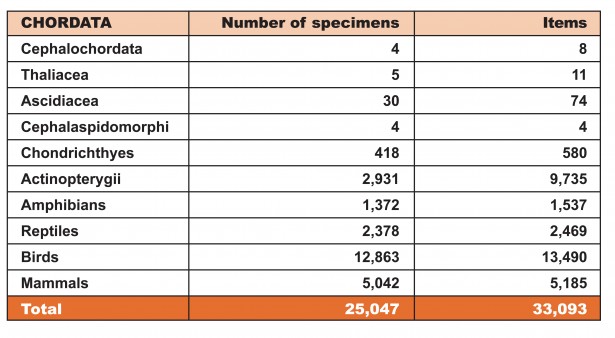The Collection of Vertebrates at the Museum includes not only this vast group (it represents the 99% of the collection) but also other taxa of chordates.
Chordates phylum encompasses all animals that have a neural tube (cord) running along their back at some stage in their life cycle; in many chordates this tube is protected by a bony column, the vertebral column. Chordates thus include vertebrates and various groups of marine animals that have a neural cord.
At present, the Museum’s Chordata collection contains over 34,000 specimens, of which less than 2 % are regularly on display. The largest specimen by far is the assembled skeleton of the common rorqual, hanging from the ceiling in the Museum entrance hall, at the Forum Park. The smallest is most probably a specimen of a shrew or frog.
The Museum’s oldest specimens date back to the time when the Martorell Museum was founded. During the period the Natural Sciences Board was operative (1893-1940), the Museum received numerous donations, made purchases and actively collected specimens, building up a sizeable collection of vertebrates. In recent decades, further additions have been made thanks to passive collecting done by naturalists and animal casualties sent to the Museum from the Fauna Recovery Centres of Catalonia and Barcelona Zoo. Donations are also received from private individuals, a few teaching centres and other museums. Our growth policy for the collection is aimed at obtaining full series of material on the different types of each species of native fauna. The selection criteria for specimens that are incorporated into the collection are, on the one hand, the adequacy of the documentation provided with them and on the other, their condition of conservation.
The vertebrates in the collection are used for scientific studies in biology, palaeontology and medicine, which are carried out by Spanish and foreign researchers. In addition, some of them are exhibited here and in other science museums. They are also used for educational purposes here and in other centres.
- Collection fund
- Preparation and preservation
TXT
-
Chondrichthyes or cartilaginous fishes
The Chondrichthyes collection (sharks and rays) consists mainly of native specimens preserved in alcohol. The groups best represented are the Carcharhiniformes, Squaliformes and Rajiformes.
-
Actinopterygii or bony fishes
Actinopterygii or bony fishes are preserved whole in alcohol. The groups best represented are the Perciformes, Gasterosteiformes, Gadiformes, Scorpaeniformes and Cypriniformes. Most of the specimens are from the western Mediterranean coasts, although there are some noteworthy batches of exotic species from the African Atlantic coast, Bolivia and Mexico. The specimens exhibited are naturalised, and in some cases replicas have been made.
-
Amphibia
The Amphibia collection consists of specimens mainly of native species, preserved in alcohol. Anura (frogs and toads) and Caudata (newts and salamanders) are represented in similar proportions. Their provenance is basically Catalonia and Aragon.
-
Reptiles
The Reptiles collection consists of specimens mainly of native species, preserved in alcohol. Comprised predominantly of snakes and lizards, it also contains some tortoises, turtles and crocodiles. The specimens are mostly from Catalonia, the Balearic Isles and Aragon. Most of the exotic fauna are from South America (particularly Colombia and Venezuela), Morocco and Equatorial Guinea. Many specimens are preserved in alcohol, although in recent years various species have been naturalised and some skeletons have been assembled.
-
Birds
Birds comprise the largest collection of vertebrates, amounting to over 12,000 specimens, more than half of which pertain to native species, although there are some prominent batches of exotic species from Ecuador, Equatorial Guinea, Morocco and Vietnam. The extensive representation of bird species in the collection is due to the Museum’s longstanding tradition in the study of birds, and to the fact that this is a group which attracts naturalists. Various types of specimen material are conserved: naturalised specimens, skins for study, disarticulated skeletons, assembled skeletons, outstretched wings, feathers, nests and eggs.
-
Mammals
The collection of mammals is largely a study collection, that is, a collection of skins and disarticulated skeletons. The largest group is that of rodents, but Artiodactyla, carnivores and primates are also prominent. Around half of the mammals in the collection correspond to specimens harvested in the Iberian Peninsula. The collection of mammals from Equatorial Guinea and from the rest of Africa in general is also noteworthy. In the last fifteen years this collection has doubled in size.
In order to preserve zoological specimens, whether whole specimens or separate body parts, they must be treated in such a way as to completely arrest the process of deterioration to which dead organic matter is normally subject. The Museum has a workshop/laboratory where the animals to be conserved whole are prepared in preserving liquid, and where partial specimens – skin for study, disarticulated skeleton, outstretched wing, tissue sample, etc. – are appropriately prepared. Depending on the needs of the Museum and the type of material it receives, some specimens are naturalised and some vertebrate skeletons are assembled. Find out how the naturalisation of a jaguar is done.
Once the specimens are prepared, they are kept in store until they are needed for research or dissemination purposes. Preventive conservation at the Laboratori de Natura is based on the prevention of possible damage by insects and on the use of mechanisms to ensure stable and appropriate environmental conditions for the material. Some vertebrate specimens are restored to improve their condition of conservation and also, in some cases, to improve them aesthetically.

